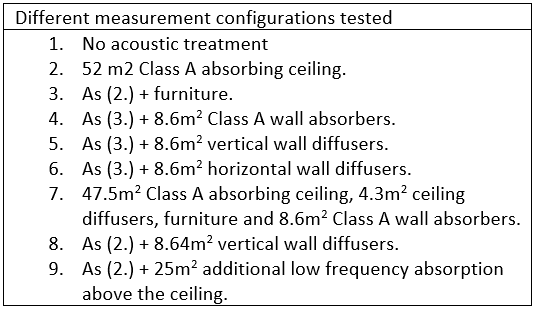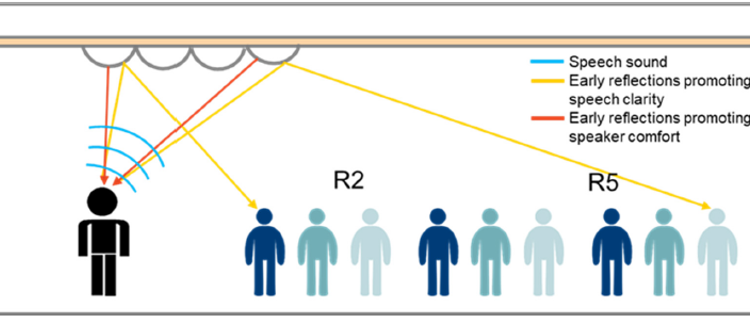
This study provides information on how different acoustic treatments can be used to obtain different room acoustic qualities, and can be used to improve and fine-tune the room acoustic parameters for better speech and listening conditions in classrooms.
The background overview
The most common acoustical treatment in ordinary classrooms is a suspended sound absorbing ceiling. However, due to the non-uniform distribution of the absorbent material (on one plain), the classical diffuse field assumption is not fulfilled in this setting. In addition, the sound scattering effect of non-absorbing objects such as furniture is significant and the directional characteristics of the sound scattering objects needs to be considered in these types of rooms. The sound decay curve in rooms with absorbent ceilings often demonstrate a double slope.
Moreover, using reverberation time alone as a standalone parameter is potentially an unreliable room acoustic measure. For a more accurate assessment of the room acoustic conditions, we therefore need supplementary parameters. The aim of this experimental study is to show how various acoustical treatments affect reverberation time T20, speech clarity C50 and sound strength G (room gain).
The experiment was performed in a mock-up of a classroom and results demonstrated how absorbers, diffusers and scattering objects influence room acoustical parameters.
The 55m2 mock-up classroom dimensions (7.32×7.57×3.5m) and measurement positions.
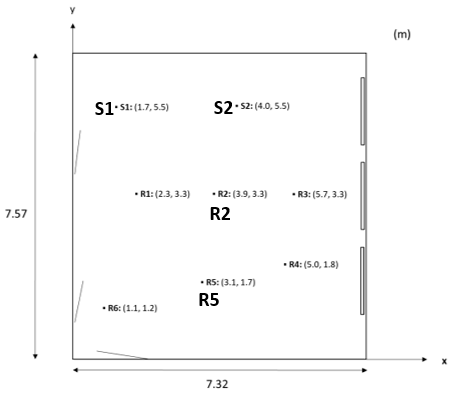
It is shown that to some extent the parameters can be adjusted individually by using different treatments or combination of treatments. In addition, this allows for the fine-tuning of the acoustical conditions to not only fulfill minimum requirements but also achieve a high-quality sound environment for a variety of speech communication activities.
The diffusers size and specific acoustic properties
The diffusers used were made of a wood frame with a curved hardboard surface facing. All diffusers
tested had the same geometry and dimensions 600x600x100mm, see below. There are open air gaps on the sides which in combination with the enclosed volume gives the diffuser a Helmholtz resonance in the frequency range of 125–250 Hz.
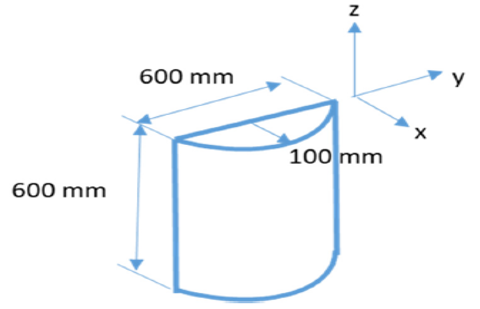
The diffusion characteristics we´re measured in a semi-anechoic chamber. The reflected energy was estimated from impulse responses using windowing techniques, excluding the direct sound.
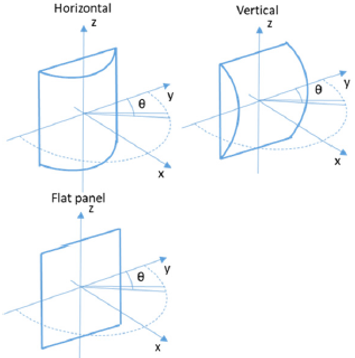
The diffusers were tested in both a vertical and horizontal orientation.
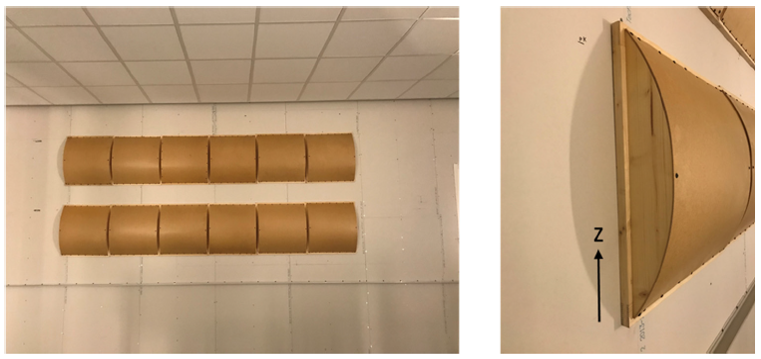
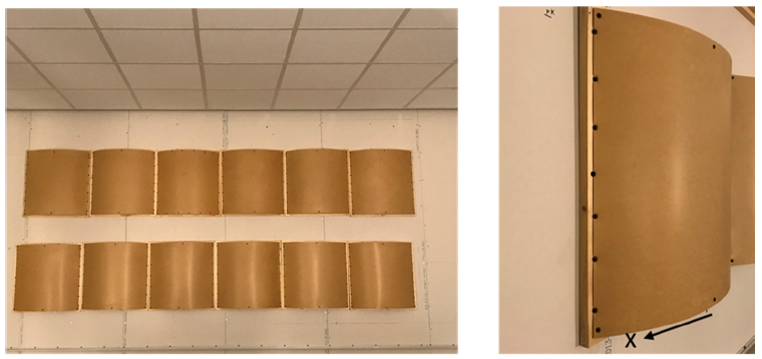
Diffusion characteristics were most significant at 2000Hz with the assumption of symmetrical properties being applied.
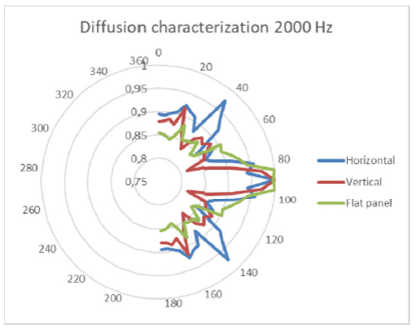
Overview of the nine measurement configurations:
Results: Effect of the ceiling absorption and furniture.
• Regarding Sound Strength “G” (room gain), in graph a. we can see the influence of the furniture would be around 1dB (a just noticable difference) in the mid and high frequencies.
• Regarding Speech Clarity C50 in graph b we see a 3 & 2dB increase at 500Hz and 200Hz respectively
• Regarding Reverberation Time T20 in graph c we see a reduction of nearly half at 500Hz with less reduction a 1000 & 2000Hz
Ceiling installation affects all frequencies, whereas the furniture has most affect from 500-2000Hz. All parameters are affected by the furniture with the greatest differences seen for C50 and T20.
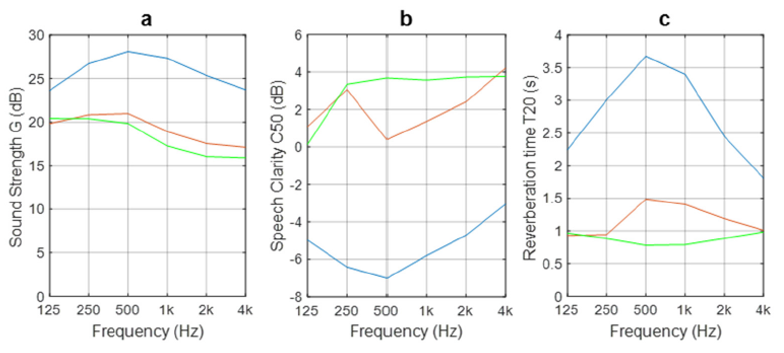
Blue curve: room with no acoustic treatment (empty)
Red curve: room full Class A absorbing ceiling
Green curve: room with full Class A absorbing ceiling & furniture
Comparing the measured T20 value with the calculated value highlights where T20 can give misleading values where a diffuse sound field is assumed using Sabine’s Formula. It shows substantially lower values across all frequencies and misses the scattering effect of the furniture in the high frequencies.
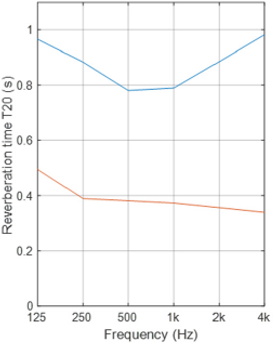
The effect of acoustic treatment on the walls on the same three parameters
Full covering Class A ceiling absorption with sparse furnishing, compared with having three different types of wall coverings; Class A absorbing, vertically orientated diffusers and finally horizontally orientated diffusers.
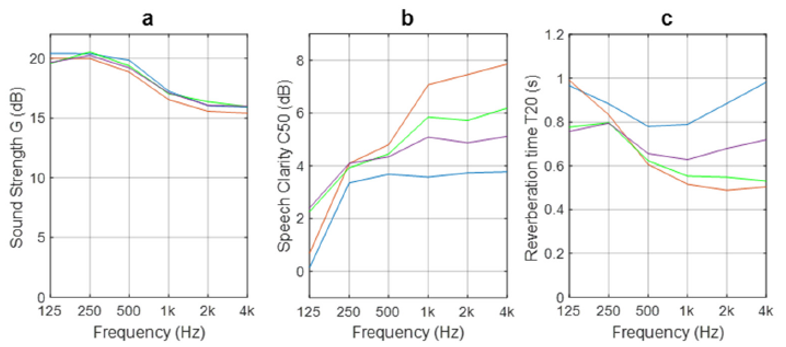
Findings from the above graphs…
The configuration with wall absorbers results in lower sound strength values in the frequency range 250-4000Hz in comparison to the configurations with diffusers and no wall treatment. The lower sound strength values for the diffusers at 125Hz is not correlated to scattering but it is due to the resonance absorption which was included in the design of these diffusers.
Regarding speech clarity, the largest increase is seen with wall absorbers from 500-4000Hz, while the diffusers increase is largest at 4000Hz for both vertically and horizontally orientated panels.
The two diffuser configurations have similar C50 values 125-500Hz where the diffusers are less effective however the vertically orientated diffusers are more effective from 1000-4000Hz as they disrupt the lateral sound field and redirect to the absorbent ceiling. The same behaviour is evident with T20 whereas a change in the behaviour was seen at 125Hz for both C50 and T20 with both diffuser configurations and again the change in sound strength was due to the diffusors resonance absorption.
The impact of the ceiling diffusers…
Absorbent ceiling panels were replaced with 4.3m2 of diffusers above / slightly in front of the typical speaking position. In addition, there were 8.4m2 of wall absorbers with sparse furnishing.
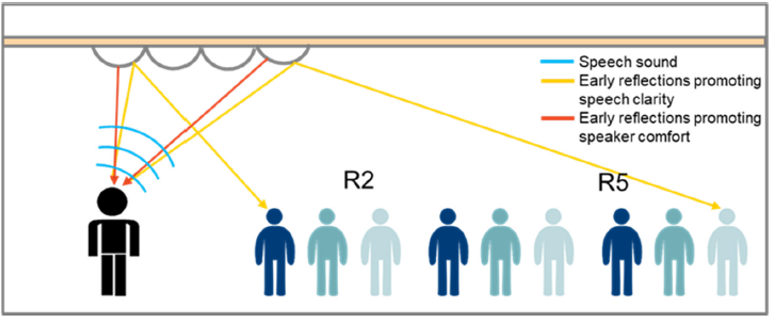
Below are the average values (inc. R2 & R5), showing a general decrease in both G and T20 and an increase in C50.
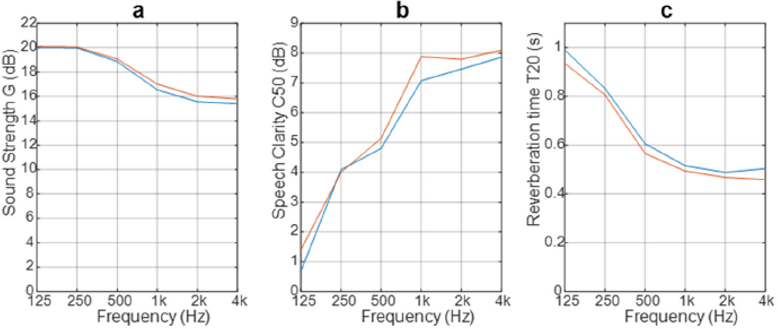
Red curve is the mix of ceiling absorbers and diffusers
The mix of ceiling absorbers and diffusers gives a lower G. The diffusers increase the C50 above 500Hz with the largest increase at 1000Hz. T20 decreased with the diffusers across all the frequencies.
The effects of the ceiling diffusers were measured at different receiver positions (R2 &R5). G was seen to decrease over distance however the diffusers showed higher values. In addition to this increased energy level, there was a significant increase in C50. At the back R5 position while there was a difference across all frequencies, the strongest effect was 1000-4000Hz, again T20 was also mainly affected in the higher frequencies.
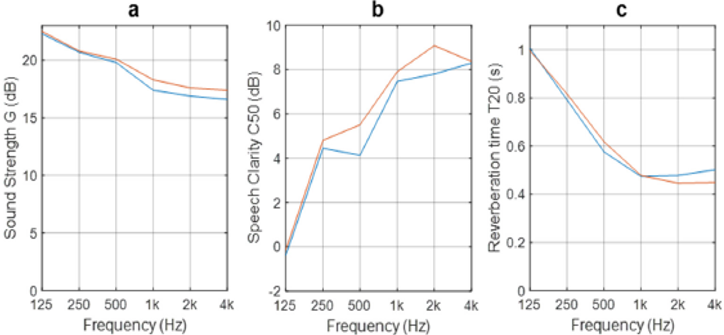
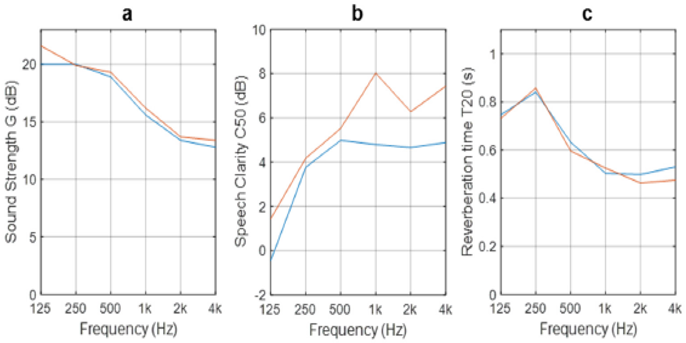
For both receiver positions R2 & R5 there was a small increase in G and a significant increase in C50 and slightly lower T20 however the strongest improvements were apparent in receiver position R5 in the frequencies 1000-4000Hz.
The results combining diffusers with Hemholtz absorbers…
The diffusers in this study were designed as Hemholtz resonators specifically tuned to perform optimally from 125-250Hz. In addition to an absorbent ceiling, adding additional low frequency absorption lowers T20 at 125 & 250Hz however the measurments show the diffuser with low frequency resonators lower T20 very effectively across all frequencies.
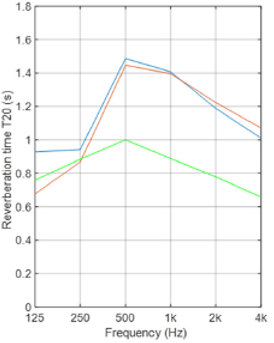
Red curve represents the ceiling with a low frequency porous absorber.
Green curve represents the absorbent ceiling with vertically orientated
combined wall diffusers / Hemholtz resonators.
Discussion around the acoustic design findings in steps and fine-tuning:
1. Installing a fully covering “Class A” absorbent ceiling in the empty room affects all the parameters and is a good baseline for classroom acoustics as it decreases the sound strength and reverberation time and increases speech clarity.
– The addition of furniture increases sound scattering at 500 & 1000Hz.
– It is important to note the difference between measurements and calculated T20 using a diffuse sound field theory in this configuration.
– The much lower values achieved in calculation demonstrate that the lateral sound field must be considered.
2. The additional acoustic treatment in the different configurations using absorbers and diffusers contributed important effects for fine-tuning the acoustics.
– Higher sound energy levels were obtained for configurations with diffusers and lower energy levels for configurations with absorbers.
– Both types of acoustic treatment affected speech clarity C50 and T20 reverberation time.
– With diffusers, energy is conserved, compared to the absorbers where the energy is reduced, explaining why both horizontally and vertically orientated diffusers have similar values in terms of sound strength G.
– The vertically orientated diffusers reduced the sound waves in the horizontal plane and directed the sound into the ceiling, showing the importance of directional scattering in rooms with ceiling treatment which correlates well to the diffusion characteristics of the diffusing elements.
3. In the configurations with diffusers placed in the ceiling, important improvements for receivers located outside the direct sound field could be achieved. Keeping the sound energy level, a significant increase in speech clarity was found for the receiver at the back.
– This is an important application for use in classrooms where a teacher gives verbal instructions from the front of the room where T20 is reduced and G increased.
– This again raises the question of the importance of considering the effect of scattering.
Conclusion:
A clear trend in how different types of acoustic treatment affect room acoustic parameters has been demonstrated where, as a baseline, an acoustic ceiling should be used to decrease the energy level, increase the ratio of early-to-late reflections and lower reverberation time.
However, in sparsely furnished rooms, it can be difficult to achieve a high-quality sound environment with only an absorbent ceiling. In this scenario, the important room acoustic parameters can be fine-tuned by using diffusers as absorbers on the walls and / or in the ceiling combined with the absorbent ceiling.
The two different types of treatment operate differently and create distinctive experiences for people in the room.
• Additional porous absorbers G & T20 are decreased and C50 is increased
• While the diffusers affect C50 and T20 in a similar way they keep G either stable or increased, depending on the placement and the amount of coverage.
• Diffusers can be used for speaker support and direct the sound to improve the speech clarity also in positions further away from the speaker
The diffusers used in this study were designed to be efficient at absorbing sound at 125 and 250Hz however this frequency range can be adopted as can the frequencies which the object scatters depending on the demands. The target values or the room acoustic parameters must be defined for the specific environment and crucially the speech communication activities, in order to use this information to fine-tune acoustic environments appropriately.
Lead Author Emma Arvidsson Industrial PhD student at Lund University, at the Dept. of Engineering Acoustics says:
“This project is building on the knowledge development which has been carried out for many years at Ecophon and it is great to build on this as I like to focus on creating good sound environments in ordinary everyday rooms, where typically people spend many hours. Depending on the users activities, the requirements differ in these rooms. I believe the knowledge from this study can be helpful in the acoustic design phase to inform about the most optimal acoustic treatment depending on the activity.”
Overall, Emma’s research focuses on how to improve the acoustics in ordinary rooms (like classrooms) by studying the interaction between the sound field in an ordinary room, the scattering effect and the material properties of acoustic treatment. Emma’s PhD supervisors are Adjunct Professor Erling Nilsson and Associate Professor Delphine Bard Hagberg both Dept. of Engineering Acoustics, Lund University and Ola Karlsson, the R&D and Innovation Director at Saint-Gobain Ecophon AB.
Read the full research paper which can be downloaded from the MDPI link here. For more information about this ongoing project please contact Emma here.

